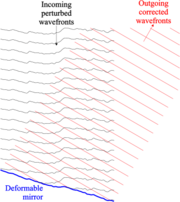Adaptive optics
|
|
Adaptive optics is a technology to improve the performance of astronomical (usually) telescopes by reducing the effects of atmospheric distortion, or twinkling. Adaptive optics works by measuring the distortion and rapidly compensating for it either using deformable mirrors or material with variable refractive properties. While the technique was theoretically understood for some time, it was only advances in computer technology during the 1990s that finally made the technique practical. Adaptive optics should not be confused with active optics, which works on a longer timescale to correct the primary mirror geometry itself.
When light from a star or another astronomical object enters the Earth's atmosphere, turbulence introduced (for example, by different temperature layers and different wind speeds interacting) distort and move the image in various ways (see astronomical seeing for a full discussion). Images produced by any telescope larger than a few centimeters are blurred by these distortions. For example, a 2.5m telescope is reduced in resolution by a factor of between 7 and 20; in the case of very large telescopes (8m+) (like the VLT or Keck), which are theoretically capable of milli-arcsecond resolution, the loss can be a factor of 50-100.
Shack_hartmann.png
An adaptive optics system tries to correct these distortions, using a wavefront sensor which takes some of the astronomical light, a deformable mirror that lies in the optical path, and a computer that receives input from the detector. The wavefront sensor measures the distortions the atmosphere has introduced on the timescale of a few milliseconds; the computer calculates the optimal mirror shape to correct the distortions and the surface of the deformable mirror is reshaped accordingly.
In order to perform adaptive optics correction, the shape of the incoming wavefronts must be measured as a function of position in the telescope aperture plane. Typically the circular telescope aperture is split up into an array of pixels in a wavefront sensor (either using an array of small lenslets or a curvature sensor which operates on images of the telescope aperture), and the mean wavefront perturbation in each pixel is calculated. This pixellated map of the wavefronts is fed into the deformable mirror and used to correct the wavefront errors introduced by the atmosphere. It is not necessary for the shape or size of the astronomical object to be known - even Solar System objects which are not point-like can be used in a Shack-Hartmann wavefront sensor, and time-varying structure on the surface of the Sun is commonly used for adaptive optics at solar telescopes. The deformable mirror corrects incoming light so that the images appear sharp. Because a science target is often too faint to be used as a reference star a nearby brighter guide star can be used instead. The light from the science target has passed through approximately the same atmospheric turbulence as the reference star's light and so its image is also corrected, although generally to a lower accuracy.
The necessity of a reference star means that an adaptive optics system cannot work everywhere on the sky, but only where guide star of sufficient luminosity (for current systems, about magnitude 11-12) can be found very near to the object of the observation. This severely limits the application of the technique for astronomical observations.
An alternative is the use of a laser beam to generate a target (a Laser Guide Star, LGS) in the atmosphere. The LGS can then be used as a wavefront reference in the same way as a natural guide star - except that (much fainter) natural reference stars are still required for image position (tip/tilt) information.
Other approaches that can yield resolving power exceeding the limits of atmospheric seeing include Speckle interferometry, Lucky Imaging and space telescopes such as NASA's Hubble Space Telescope.
Uses of adaptive optics
Besides its obvious use for improving nightime astronomical imaging, adaptive optics technology has also been used recently to image individual cone photoreceptors in the living, human eye. It is also expected to play a military role by allowing ground-based and airborne laser weapons to reach and destroy targets at a distance including satellites in orbit. Adaptive optics is used for solar astronomy at observatories such as the Swedish Solar Telescope.
See also
External links
- Description of Active & Adaptive Optics (http://www.eso.org/projects/aot/introduction.html)
- Using Adaptive Optics to image photoreceptors (http://www.cvs.rochester.edu/people/d_williams/ao_research/ao_research.htm)

